Contemporary artist Benjamin Weaver talks about his journey as a painter for over 25 years, in an interview with Anjali Singh for the Asian Curator.
I have been working to develop a balanced aesthetic that emphasizes spatial relationships. I hide the complexity of form behind a seemingly simple and pleasing product.
Contemporary artist Benjamin Weaver
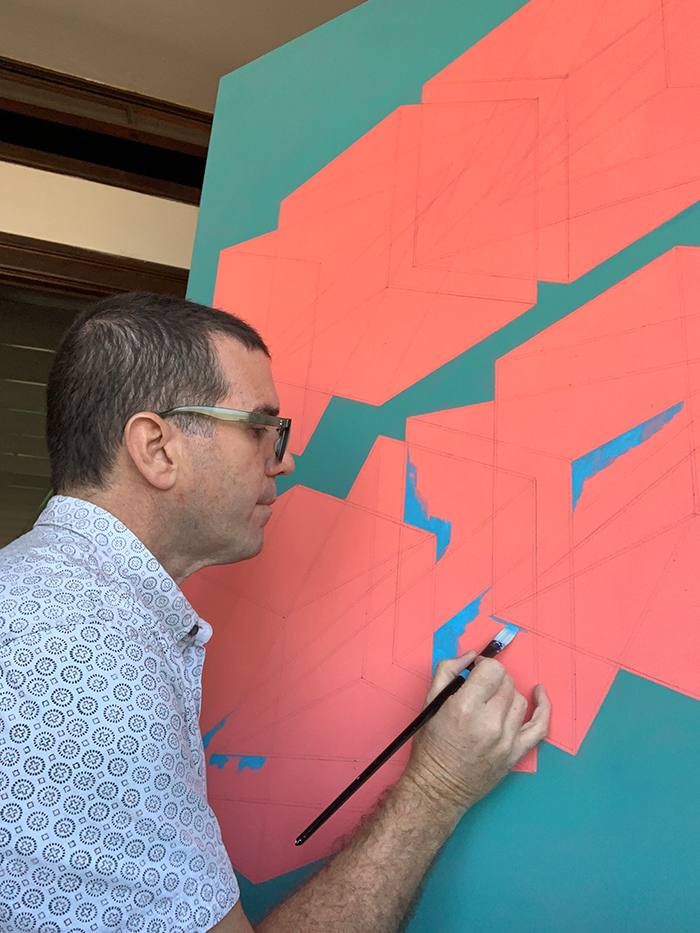
I want the viewer to recontextualize the work so the subject matter becomes their own.
Contemporary artist Benjamin Weaver
Please tell us a little about yourself
Philadelphia and the surrounding suburbs has been my home my whole life. My concentration in the later part of my artistic career has been on painting but I have also enjoyed sculpting in clay, casting work in bronze, and carving directly in wood. I exhibit in local galleries and have had juried shows throughout the Mid-Atlantic region. The technical and conceptual elements of painting capture much of my creative energies. Each year I work on several series with themes that I believe challenge me to push myself and I think that progress can be seen in the work itself.
How do you describe yourself in the context of challenging people’s perspective via your work?
As an artist, I challenge others’ perspectives about my work, by helping them internalize the spatial elements in order to give them the possibility that the relationships can hold meaning through the viewer’s perspective. My goal is to present the work, and then take a step back in order to see how the viewer contextualizes the work from their own point of view.
I have been working to develop a balanced aesthetic that emphasizes spatial relationships. I hide the complexity of form behind a seemingly simple and pleasing product. Flattened transparent three-dimensional forms can recede or come forward depending on perspective. I use that concept and color to suggest an outlook but there is no one correct viewpoint. In fact, the use of apparent transparency shows multiple viewpoints at the same time. The universal language of simple geometry is used as a starting point to bring viewers into the conceptual space. I see the individual elements within the painting as a math problem or thought experiment. Once those formulas are accepted by the viewer, he or she can internalize the spatial relationships and thought process. I do not insert a specific narrative into the painting. I want the viewer to recontextualize the work so the subject matter becomes their own.
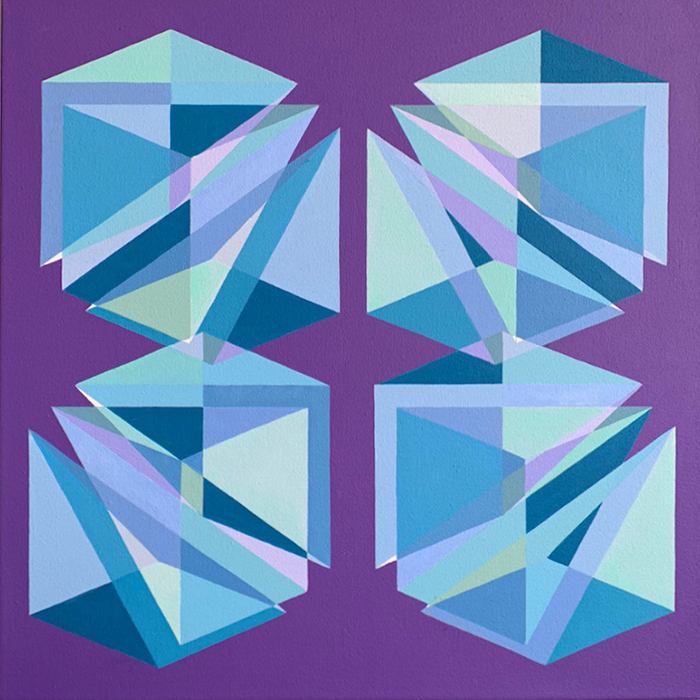
What brought you to the world of contemporary visual art and how did you start?
After college, I painted and sculpted in my free time. I painted introspectively and was not involved in the greater art world. I was creating work for other artists through the jobs I held, but they did not always touch on contemporary visual art.
My first job out of college was in a stained glass studio. I worked in the installation and fabrication of stained glass windows. Because it was such a small studio, I was occasionally able to design and enlarge some work.
I then spent eleven years at a fine arts foundry. The first five were as a metal worker. I assembled and finished large and small bronze works. These years gave me an intense experience learning about structure and form that would have been hard to acquire in a different setting. However, what really helped me in my current spatial study was my time as a mold maker. By the time I started in this position, I was thoroughly versed in the process at the foundry.
As a mold maker, you are the first person to touch the work after the artist. There is a responsibility to think not only about the negative spatial concerns on a technical level in terms of making a mold but also for every step the piece will take in the foundry process. The work will go through several negative and positive forms before the final bronze is made. At some point, I started to think about the positive and negative forms at the same time. This thought process of both two apparent opposites being true and essential is something I try to develop in my current work. The forms could be above/below, up/down, moving forward/back, and somehow both at the same time. I didn’t realize at the time, but this changed how I thought about space.
I didn’t truly get a sense of contemporary art until I became a preparator in a museum. Was exposed to both historical and current contemporary art. Handling these works gave me a close up view of them that not many people have the pleasure to experience. But it also allowed me to study the difference in quality and content of works that are valued in the broader art world.
Let’s talk about your frameworks, references and creative process.
The jobs I have held taught me the value of craftsmanship and efficiency not only in practice but in the end product. As I work on my craft, I try to create paintings that themselves are the focus of the viewer and that I myself should recede from the viewer. This framework is hard to describe in our current culture self-promotion and branding oneself or even discussing the expectation of the artist to participate. If my work is strong it shouldn’t have to be explained by the narrative of my life. The universal concepts of color, form, and design should hold enough sway with the viewer to process the theoretical concepts within the painting without being overwrought with personal meaning from the artist.
My creative process is not to create a single painting. I choose to create works in series. Each series is part of the trajectory. Some concepts will have developed years earlier but slowly come to the surface over time. Often, a concept I might have touched on briefly in the past will erupt into a full series years later. Years after experimenting with a concept, I find myself understanding it much better and utilizing it with great effectiveness. This is one of the great benefits of working in series and allowing the context of the work evolve.
What would you call your style?
Relative Geometry would be a good way to describe my work. I use hard edge, high contrast paint to express potential movement; with a suggestion that there could be a resolution to the spatial design problem in each painting. I consider myself a formalist and hope that everything needed to enjoy and understand the painting is there on every canvas.
I also look to employ practical design problems to visual elements, and I develop the underlying structure and proportions first. Then I look to emphasize or deemphasize elements with colour,
design, or painting techniques. Sometimes these concepts are developed under a larger umbrella of a series but at times the work develops out of the previous painting. When each work is complete, it is very important to me to know what I would like to change and what I loved about the painting and hope to expand. This self-criticism was difficult in the beginning but has been an essential part of my practice. I could have never gotten to where I am now without developing a healthy sense of what I could do better and what clearly works in each individual painting.
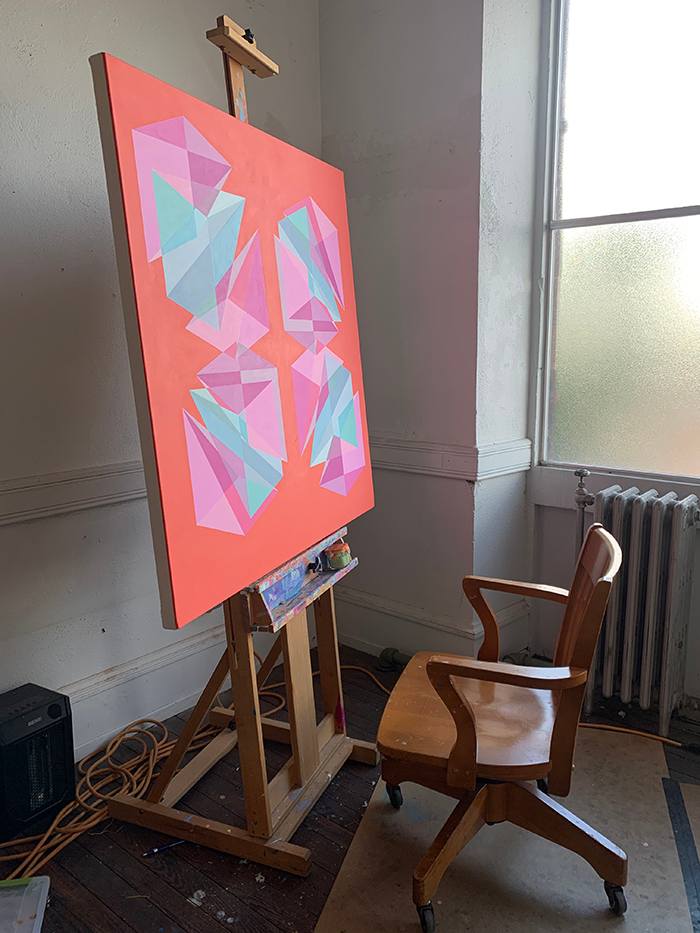
Let’s talk about the evolution of your practice and medium of art over the years.
I have always painted; acrylics, oil, and watercolor. However, that has not discouraged me from making serious inroads at other mediums along the way. I have sculpted both in clay that I have cast into bronze and direct carving in wood. Originally I created abstracted figures in paint and bronze. I loved creating the work, and understood what I was trying to communicate on a base level. However, I never seemed to be able to communicate the relationships between the figures in the purest sense that I wanted. I found that the viewer wanted to contextualize the figures instead of how they related to each other. Over time I clarified relationships as a primary reason to create the work. The abstracted forms seem to be a clear way to both show and obfuscate relationships.
Tell us about your commitment to your current medium in art.
I have put sculpture aside and am now painting full time. And I find the process itself very enjoyable and rewarding. I paint whether I have a show scheduled or not always keeping in mind what the series may demonstrate if in a complete gallery show. The current work might be a continuation of a concept in a different color scheme, proportion, or line.
What does the creative process mean to you?
The creative process is an intellectual process that is at work even when I am not in front of the easel. What I respect and love about the process is that it is endless. There is always something else I want to create. I love refining ideas. Enhancing or demphasizing concepts through color continues the creative process past the design stage. The conceptual spatial relationship has become a language that I can envision clearly. It exists before it is drawn on paper. The fact that it can be expressed and communicated keeps me engaged from the viewers point of view.
How do you deal with the conceptual difficulty and uncertainty of creating new work? How do you overcome creative blocks?
One of the ways I have been able to avoid creative blocks is to never start from scratch. Finding that first conceptual creative idea can be difficult and if I tried to come up with something completely new each time I would have a problem. Because I use previous work as a framework for the next series, it allows me the opportunity to do something entirely new by changing certain elements. I might want to do something similar in different colors, expand the space, confine the space, expand the elements, narrow the line, use different sized or shaped formats, or any other of an infinite number of details. I see each piece as a unique work of art but there is a long trajectory into which each piece contributes and because of that the overall work has its own language and style.
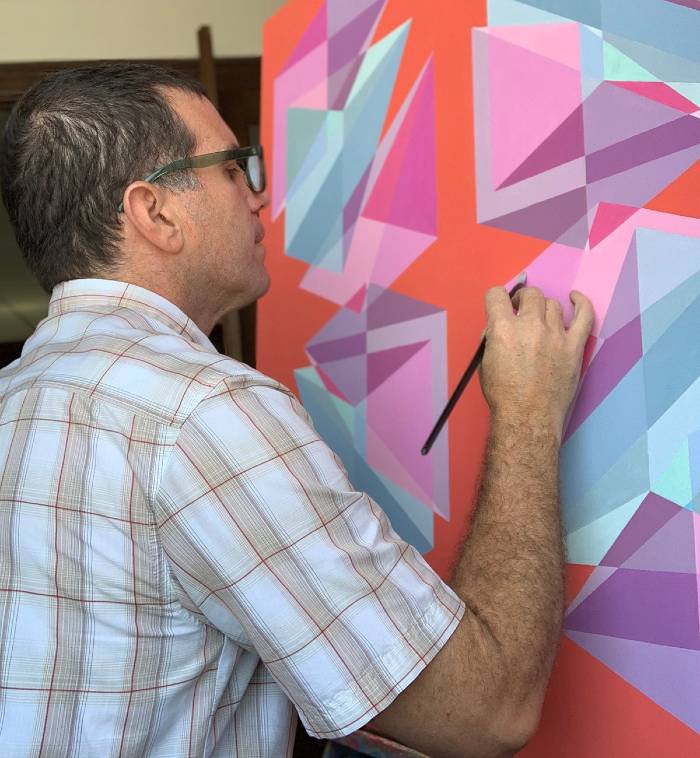
What is your source of creative inspiration?
I love the process of painting. There is a purely abstracted process that happens completely in the mind and yet there is a purely tangible aspect that happens with the brush to canvas. There is an amount of concentration required to bring the tangible back to the abstract. Due to the systematic nature of my process I get drawn into the work; before I know it the work is done, and it is hard to imagine how it happened.
What are you looking for in other visual artists’ work?
There are many visual artists that I enjoy and it has been interesting to see their work and careers develop. Instagram has been a great medium for exposing me to others with similar styles I would never have had the opportunity to encounter through gallery visits. It is exciting to see how their work develops over the years.
I look to see how much their work changes from year to year and series to series. There is so much that can be accomplished in a series of work, and some artists like to study the same concept for many years, changing format and color while other artists evolve concepts through each series of work. I am not looking to pick out one work, but I do fall for specific pieces from different artists. I would love to collect work from Paul Corio, Jan van der Ploeg, Gabriele Evertz, Samantha Bittman, Natalie Featherston, Kelly Ording, and Richard Roth.
What does contemporary visual art mean to you? What role do contemporary artists play in shaping culture and society?
I see contemporary visual art as a way to indirectly see the world and points of view. The interior life of the artist can be expressed in purely abstract forms. Whether these thoughts are clearly expressed and communicated are up to the artist. I am drawn to beautiful work that clearly has abstracted content. Sometimes it takes years to discover the language used by the artist but they tend to use common touchstones that can be found with study.
Tell us about your studio, what kind of place is it?
My studio has beautiful northern light. It is located in the Fairmount section of Philadelphia. I have two rooms with wide doors that lead to a balcony overlooking a common space. The building was converted into an artist studio space from a church hall with adjacent classrooms. There are also several large rooms that the artists can use when needed. The church envisions this as a type of residency.
Could you describe your usual work-day?
Before the pandemic, I would paint almost every weekday at my studio. This routine has been upended by the virus. Normally, I would go to the studio after my children leave for school. However, school is currently 100% virtual in our community. I have shifted to painting at home most days. When they have an asynchronous school day, I bring them to the studio with me.

Let’s talk about your career as an artist, or if you prefer artistic journey. What were your biggest learning and hiccups along the way?
It’s hard to describe one moment of obvious failure. There was so much of my career that was accomplished quietly without an audience. My greatest concern was getting work done. I was always trying to get the next piece finished. What I should have done earlier was look up and see how other artists manage some of the problems I was facing. I could have saved myself some time and struggle. Years ago, before social media, it was much harder to understand how other artists managed their networking, marketing, and practice. Now that social media has exploded, it has encouraged the community to be open about their practices. In the past, it would have been difficult to gain access to a successful artist’s studio. Through YouTube and Instagram, I can visit their studio virtually and learn about their process and practices.
Describe a professional risk that you took. What helped you take it?
In 2017, I was approached to create a show in an unused commercial space in Bala Cynwyd for NoBA Artspaces. There was a building that was going to be renovated into apartments. The development company wanted to maintain community involvement in the area during the transition. I was one of the first artists to participate. I needed to install on short notice and gallery sit. It turned into a nice little show. The opportunity gave me reason to create a larger piece I may not have made otherwise. There was very little foot traffic. However, multiple opportunities arose out of my participation.
I posted a photo of the deinstallation of the large painting on Instagram, and within 20 minutes there was an inquiry for another solo show. This was an even better opportunity. In this second show, I was able to exhibit twice as many paintings with a significantly larger audience. I also had a second opportunity to participate in a group show in the same initial space. However, by this time the space was renovated, and there was a lot more foot traffic and it was also promoted in a local magazine. Out of this initial opportunity, I met several individuals who connected me to opportunities and sales.
Any curator who deserves special mention?
Susanna W. Gold, Ph.D. has been a valuable resource. I was initially introduced to her during the second show at Noba Artspaces. She was the curator for the second show there and has given me valuable advice, added work of mine to a university collection, and has provided me with several other opportunities over the last few years.
Best piece of art advice.
A long time ago I received a nice note from another artist, and in it there was some great advice. I cut it out and taped it to my drawing table. I kept it there until it withered away but by then it had become ingrained in me: “Refine, refine, refine.”
Let’s talk about the importance of a peer artist network & art advice
Artist advice can be tricky. There were many times early on when I thought that I could really use some advice. If only I had a greater network, I would have more opportunity for some perspective. However, I think there is a real danger for misplaced advice. The person from whom you seek advice should have a really good understanding of where you are in your career, your emphasis, practice and goals. Everyone is looking for more opportunity but networking is reliant on personal relationships and shared interest. It’s hard to know where to commit our efforts because the emphasis of our art at any given time is hard to articulate. If
others don’t know what our artistic intent is precisely it is hard for other people to help us on our path. Learning how to articulate your artistic intent is critical to network effectively.
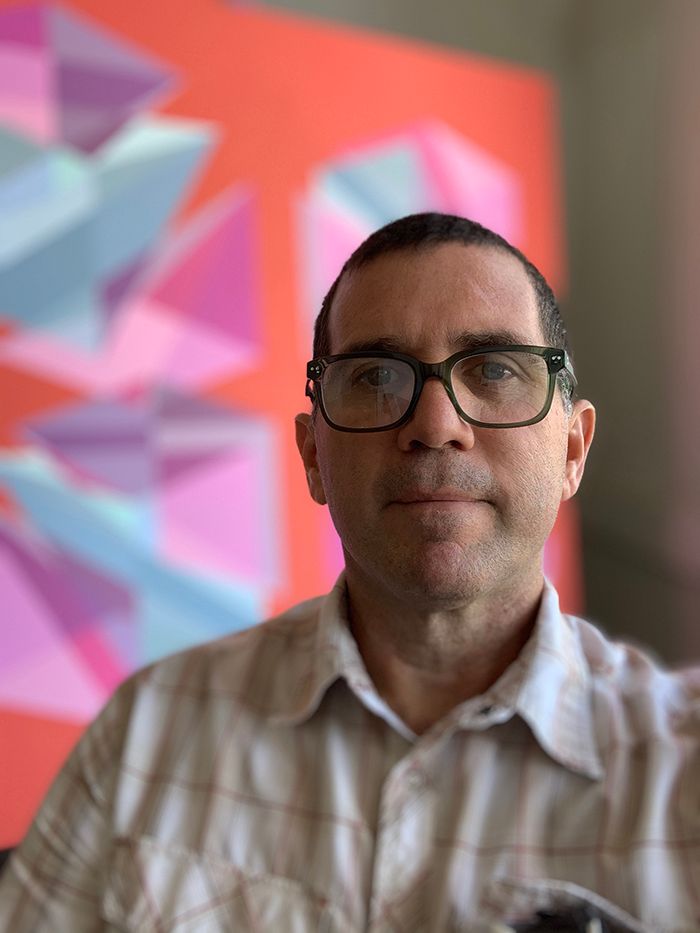
Is it imperative to have a visual art degree become a visual artist?
I do not have a visual art degree. I do not believe it is absolutely necessary but I would suggest understanding what that might mean for the individual. If I wasn’t exposed to the hard work and dedication of my parents, I wouldn’t have had the example I needed to do this on my own.
My parents were always working long hours, studying for the next degree, practicing their instruments, and participating in their hobbies and communities. Watching them was incredibly influential on me. I was also able to develop healthy self-criticism. Understanding what you want to improve technically and conceptually takes extra time but I feel that if you can make it on your own terms, you get to it honestly and because of that it is easier to be dedicated. By choosing not to get a visual arts degree, I do feel as though I missed out on early group shows and collaboration. I also missed a sense of community and common cause that can be helpful early on in your career.
Are you more of a studio artist or naturally collaborative by nature?
I am a studio artist and haven’t collaborated with other artists on projects. I lead a very internal artistic life in terms of creating work. I’d be interested in commissions for particular locations using the concepts and colour themes within my existing practice. The initial process of deciding what I will work on is always a design/spatial issue. The initial challenge is size, scale, and proportion. This wouldn’t change with a commission.
Do you handle art valuation and sales yourself?
I do come up with my own valuations based on previous sales. However, with any new gallery or listing I have a conversation with my exhibition partner so that we are on the same page. I have sold my own work, but increasingly I have a representative sell my work. Sometimes that is an online representative, art adviser, or gallery.
I am working on transparent cubes divided equally into three. The relationships of each third separating or coming together. I often mirror the design vertically and the objects seem to change based on the perspective of above/below. I have also been working on transparent interior cubes separating or joining their outer cubes.
Benjaminfweaver.com
Before you go – you might like to browse our Artist Interviews. Interviews of artists and outliers on how to be an artist. Contemporary artists on the source of their creative inspiration.












Add Comment